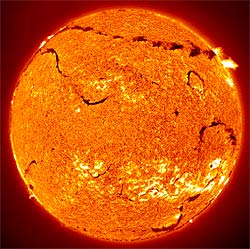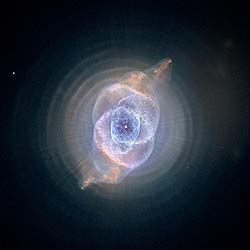
Sun-Earth Day 2007 presents: Living in the Atmosphere of the Sun
A dog's life is seven years for each human year, but a star's life passes 100 million times more slowly!
ISSUE #48: THE SUN: FROM CRADLE TO GRAVE
Birth:
About 4.6 billion years ago, an anonymous interstellar cloud began to collapse, forming many dense cores of dust and gas hidden under a thick, obscuring haze. The cores, perhaps a light year across, continued their slow gravitational implosion. As they spun faster and faster, their shapes changed from roundish globules to flattened pancakes and disks, with most of their mass falling into a central dense ball of contracting gas. Within a million years, the central core temperatures climbed above 10 million degrees and hydrogen atoms began to fuse into deuterium and helium at an accelerated pace. The enormous outward pressure provided by thermonuclear fusion quickly halted the further contraction of the fetal sun, and our sun became a full-fledged star for the first time. But the activity did not cease. As vestigial gas and dust continued to fall into the central core of the orbiting disk, it dragged with it magnetic fields left over from the distant interstellar cloud. The surface of the sun erupted in fantastic plumes and flares of solar energy as magnetic fields tangled and reconnected into newer shapes. The sun had become what astronomers call a T-Tauri star - one of the youngest recognized types of stars discovered over 50 years ago.
These magnetic fields and ejections of matter also caused the rapid spinning of the sun to slow down from its frantic pace of once-per-week to the more sedate monthly cycle we see today. Over the next few million years, a massive wind of ejected gas from the solar surface would blast through the surrounding disk of gas and dust, and clean out a zone nearly as large as our solar system. After 10 to 30 million years, the actions of these innumerable T-Tauri stars that had been born, would begin to dissipate most of the gas and dust in the original interstellar cloud that had been their nursery. As time passed, the powerful wind would slacken to a barely perceptible gale, and then a light blustery wind.
While the sun formed and began its long adolescence, out of the orbiting disk of gas and dust, incipient planet-building processes first created rocky asteroidal bodies, and through innumerable collisions, some of these bodies grew to embryonic size. At this point they grew even faster, not by chance collisions, but by exercising their gravitational pull to sweep-out the space around them like vacuum cleaners. Within 50,000 to 100,000 years the first planets to form were the gas giants, followed millions of years later by the smaller rocky planets in the inner solar system. Once formed, the giant planets felt the friction of the surrounding gaseous disk and they slowly began to fall closer and closer to the sun. Once the T-Tauri winds had completed their work, the frictional decay of orbits ceased and the giant planets took up their present orbital positions. Had the disk been too dense, or the solar winds too enfeebled, the stately progress of giant planets would have ended with their infall to the sun. Along the way, they would have ejected the planets from Mercury to Mars.

Our sun has already spent 4.5 billion years as a star, and will continue to shine normally for at least another 6 billion years as a middle-aged star before becoming a red giant. (Courtesy: Institute for Astrophysics, Gottingen)
Middle Age:
Once our sun began to produce energy in its core by fusing hydrogen into helium, it embarked on a long 'middle age' . As the nuclear fires became more efficient, the infant sun began to expand very slowly. At first the sun only shone with 70% of its modern brightness. But as it continued to evolve over eons of time, its brightness grew by 7% every billion years. When trilobites first crawled on shallow ocean bottoms 500 million years ago, the sun was much fainter in the sky than it is today. Earth would have been in a deep-freeze had it not been for the warming actions of an atmosphere laced with trace gases like water and carbon dioxide-rich.
In the eons to come, the sun will continue to expand and shine more brightly for the next 6 billion years. Then a major physical change will start to happen with unprecedented speed. The inner core has become heavily laden with the helium 'ash' of over 11 billion years of fusion. Collapsing steadily under its own weight, it has increased the temperature of the sun's core making the fusion reactions burn more fiercely, and making the sun expand to find a new equilibrium. But suddenly a tipping point is reached and the inert helium ash begins to fuse to form carbon. This unleashes a massive increase in energy and pressure and the sun's outer layers are propelled outwards, first beyond the orbit of Mercury, then Venus, and then Earth. The sun has ended its middle age as a red giant star.

Planetary nebulae are the remains of sun-like stars that have reached the end of their red giant stage, losing most of their atmosphere into space to form some of the most beautiful nebula in the Milky Way. (Courtesy: NASA, ESA, HEIC Heritage Collection)
Death:
Over the course of a few 100 million years, the sun continues to shed much of its mass into space as a red giant, and later forms a spectacular 'planetary nebula' as its last gesture. There are numerous examples known to astronomers, of what happens to stars like our sun when they reach their last few millennia of life. Spanning nearly a light year or more, the illuminated veil of gases from the dying sun expand out into space until they invisibly mix with the other gases in interstellar space. Deep within the nebula, a brilliant white dwarf remains; the last vestige of the sun seen as a hydrogen, oxygen and carbon-rich ember. At first it glows brilliant white at a temperature of 100,000 degrees, but with no nuclear fusion to sustain it, it is destined to cool to a blackened hulk after another trillion years. As the universe grows older in the vastness of time, eventually all galaxies will be dimmed, and the brilliant starlight replaced by dark stellar relics moving silently in the infinite night.
RELATED LINKS
Technology Through Time
2007 ISSUES
- #57: The Heliosphere
- #56: Coronal Mass Ejections
- #55: Solar Corona, Holes and Wind
- #54: Solar Flares... Oh my!
- #53: Solar Prominences
- #52: Sunspots from A to B - solar magnetism
- #51: The Transit of Mercury
- #50: Ancient Sunlight
- #49: Solar Energy
- #48: The Sun: From Cradle to Grave
View past issues
Authors and Designers
Space Weather Fact
Toy 'rare-earth' magnets can be 5 times stronger that a sunspot magnetic field.



